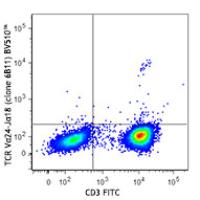-
Sign In
-

-
 Sony Biotechnology
Sony Biotechnology
-

-
 Sony Biotechnology
Sony Biotechnology
Brilliant Violet 510™ anti-human TCR Vα24-Jα18 (iNKT cell)
Antibodies Single
Sony
6B11
Flow Cytometry
Mouse IgG1, κ
Human
2314585
$203.00
Description
Encoded by the TCR Vα24-Jα18 germline configuration, Vα24-JαQ is expressed on a subset of NKT cells, namely invariant NKT (iNKT). Vα24-JαQ TCR interacts with the glycolipid loaded MHC class 1b molecule CD1d, inducing activation and subsequent cytokine production. iNKT cells have been implicated in immune regulation, tumor surveillance, and host response to pathogens. While iNKT cells occur at low frequency in the blood, assorted chemokines contribute to their tissue homing potential.
Formulation
Phosphate-buffered solution, pH 7.2, containing 0.09% sodium azide and BSA (origin USA).Recommended Usage
Each lot of this antibody is quality control tested by immunofluorescent staining with flow cytometric analysis. For flow cytometric staining, the suggested use of this reagent is ≤5 microL per million cells or 5 microL per 100 microL of whole blood. It is recommended that the reagent be titrated for optimal performance for each application.
Brilliant Violet 510™ excites at 405 nm and emits at 510 nm. The bandpass filter 510/50 nm is recommended for detection, although filter optimization may be required depending on other fluorophores used. Be sure to verify that your cytometer configuration and software setup are appropriate for detecting this channel. Refer to your instrument manual or manufacturer for support. Brilliant Violet 510™ is a trademark of Sirigen Group Ltd.
This product is subject to proprietary rights of Sirigen Inc. and is made and sold under license from Sirigen Inc. The purchase of this product conveys to the buyer a non-transferable right to use the purchased product for research purposes only. This product may not be resold or incorporated in any manner into another product for resale. Any use for therapeutics or diagnostics is strictly prohibited. This product is covered by U.S. Patent(s), pending patent applications and foreign equivalents.
References
1. Rout N, et al. 2010. PLoS One 5:e9787. (FC)


